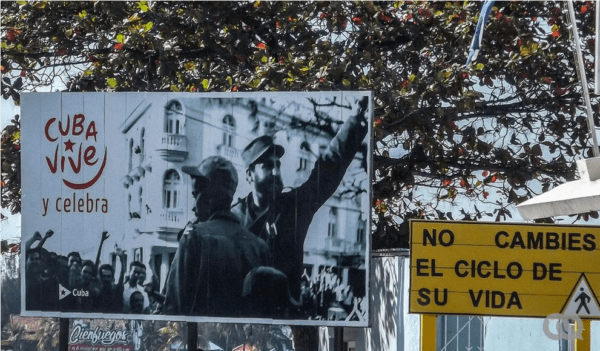Goosebumps in Cuba. Why and Until When?

By Eloy Viera Cañive (El Toque)
HAVANA TIMES – #MiraSiMeErizo (Look and see if I get goosebumps) is the latest challenge on Cuban social media. Its origin is linked to the statements of some residents of Rio Cauto after the visit of Miguel Diaz-Canel to that locality in January 2024.
The verb “erizar” means “to raise, make something stiff, especially hair” and is associated with situations of intense emotion or cold. It is also used to describe events that provoke intense or stirring reactions.
The act of getting goosebumps in front of the cameras on Cuban television is not new and has been a fundamental narrative element of propaganda in Cuba. One of the people who made statements in Rio Cauto claimed they had goosebumps when, upon seeing Diaz-Canel, they remembered “God Fidel.” Who wouldn’t get goosebumps at such a memory?
The use of political eccentricity and the goosebumps it provokes has been an eternal part of the totalitarian way of doing politics in Cuba. It implies deifying officials and preventing people from publicly getting excited about anyone who represents opposition to the Castro regime that Diaz-Canel embodies today.
Such is essential for a system that cannot demonstrate its legitimacy through common democratic mechanisms that exist elsewhere and needs to show that, at least, it retains the ability to move “emotions.”
But the crucial issue does not lie in whether people get goosebumps in front of a deflated figure like Diaz-Canel, who reached where he is not by the will of the citizens, but because a handful of ninety+ year olds decided so and still have to accompany him to show support. Each individual has the right to get goosebumps with what they understand. The conflict in Cuba lies in the authenticity of the reactions and the real causes that provoke them.
Few situations generate more self-censorship and insincere performances in Cubans than when facing a camera and a microphone. Popular memory is marked by several “classics” that demonstrate this. Perhaps one of the most illustrative is that of the mother contradicted by her daughter who denies attending church while claiming to be revolutionary at a time when the Revolution and religion were incompatible.
I don’t think there are many people in Cuba who get goosebumps at the sight of Díaz-Canel. Unlike Fidel Castro, Diaz-Canel is a construction of the regime. He is merely the survivor of a generation that the ninety-year-olds prepared to succeed them, as Raul Castro noted.
If someone gets goosebumps at the sight of Diaz-Canel, it is likely not because of his charisma or his ability to charm people, but because they still believe that one must get goosebumps before anyone who embodies Castroism. Today it’s Diaz-Canel, but tomorrow it could be anybody if the Communist Party so decides.
The most sincere goosebumps in Cuba are not caused by Diaz Canel or any other top leader, but by fear. The fear of knowing that in front of the camera, there is only room for a single discourse, that of support and reverence for the divinity embodied by the “Revolution” and its highest officials.
So entrenched is the idea that sometimes not even the propagandists can detect when Cuban mockery plays with them and exposes them. In this sense, the contribution to national culture made in 2022 by “the wizards of Marianao” stands out. That couple on a motorcycle managed to sarcastically lie and sneak in a stroke of genius during an interview on the street conducted by Canal Habana TV.
The report sought to portray Marianao as its slogan of the Republican pre-revolution era, “The city that progresses.” The people of Marianao said on television what the propagandists wanted and expected to hear. They did it to such an extent that the sarcasm was not perceived and ended up on the screens exposing the propaganda. Suddenly, in Marianao, there was what did not exist elsewhere in Cuba —water and electricity 24 hours a day and “plenty of chicken”. It provided further evidence that there is no difference between Cuban propaganda and science fiction.
That’s why I say, although I have no evidence to prove the insincerity of those who were moved by Diaz Canel’s presence in Rio Cauto, that getting goosebumps in front of a Cuban television camera can be as false as the reaction of those who renounced religion at the time or those who claimed that Marianao was Hialeah.
Faced with that truth as solid as a temple, what needs to be evaluated is not who gets goosebumps or how and with what they do it. What is increasingly urgent is the need to insist that political regimes are not legitimized by the number of people who get goosebumps in front of their officials. What is important is to insist that this is a staged performance that does not reflect the reality experienced by Cubans.
Democratic political regimes are legitimized by the coexistence of divergent political forces and voices and by the solitary vote of the citizenry. Perhaps the sincerest goosebumps will occur in millions of Cubans when they can face in a closed booth —without being scrutinized by a television camera or by State Security— a ballot with at least two candidates. And one of the candidates must be the embodiment not of Castroism, but of its real and true opposition.
After that day, getting goosebumps will be the least of our problems.





